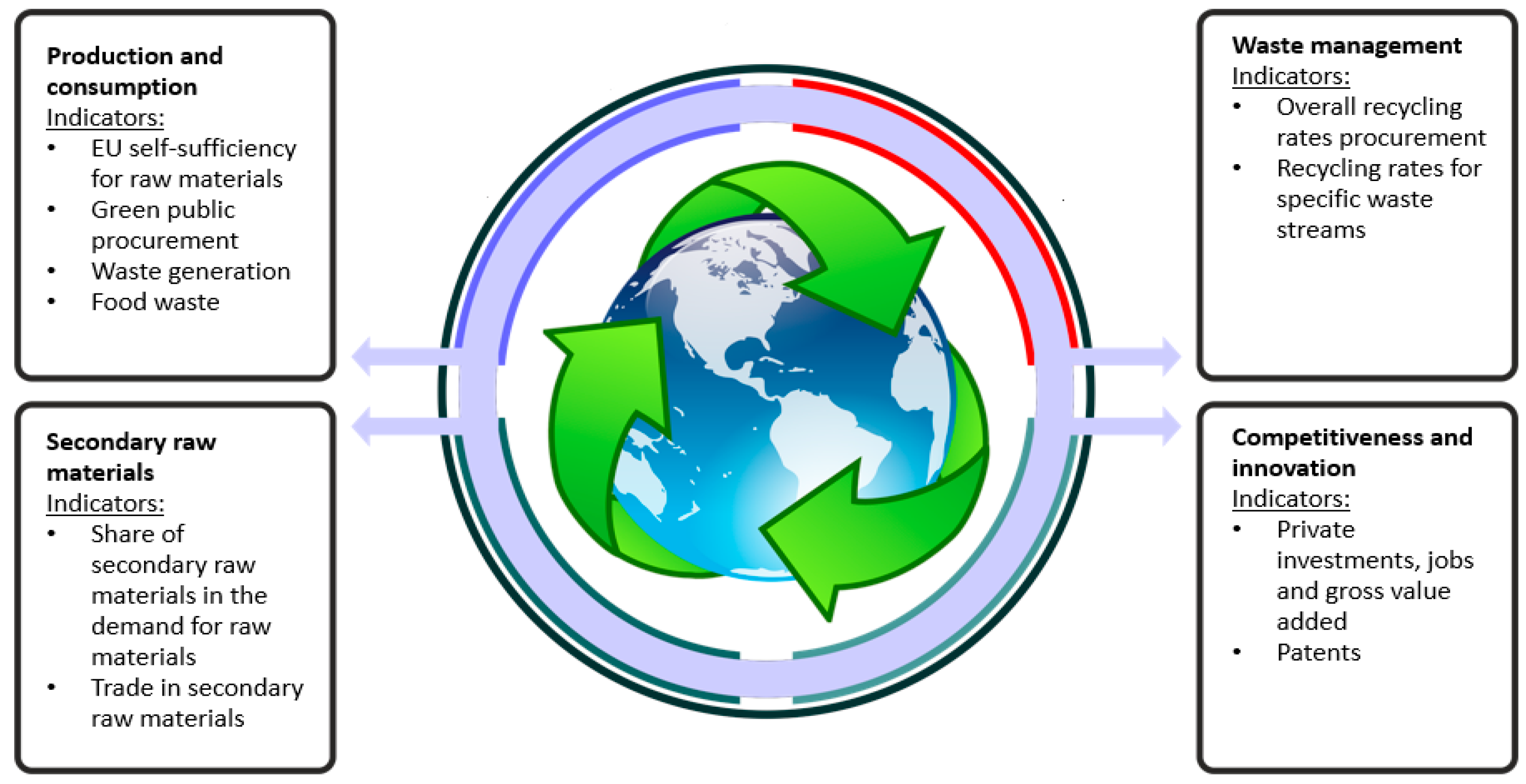Importance of Sustainable Mineral Resource Management in Implementing the Circular Economy (CE) Model and the European Green Deal Strategy
Abstract
1. Introduction
2. Materials and Methods
3. Inventory of Mineral Resources Management on the European Level
3.1. Importance of Mineral Resources Management at the European Level
3.1.1. Management of Mineral Resources in the Circular Economy Model
- Communication No. 398, 2014. Towards a circular economy: A zero waste programme for Europe [4];
- Communication No. 614, 2015. Closing the loop—An EU action plan for the Circular Economy [5];
- Communication No. 29, 2018. Monitoring framework for the circular economy [6];
- Communication No. 98, 2020. A new Circular Economy Action Plan For a cleaner and more competitive Europe [3].
3.1.2. Management of Mineral Resources According to the European Green Deal
4. Analysis of Indicators Referring to Circular and Sustainable Mineral Resources Management
4.1. CE Indicators Presenting Mineral Resources Management
- In the area of production and consumption:
- EU self-sufficiency in raw materials;
- In the area of secondary raw materials:
- Share of secondary raw materials in the demand for raw materials;
- Trade in secondary raw materials;
- In the area of competitiveness and innovation:
- Patents related to recycling and secondary raw materials.
4.1.1. EU Self-Sufficiency for Raw Materials
4.1.2. Share of Secondary RMs in the Demand for Mineral Resources
4.1.3. Circular Material Use Rate
4.1.4. Trade in Secondary Raw Materials
4.1.5. Patents Related to Recycling and Secondary Raw Materials
4.2. Indicators Presenting Sustainable Mineral Resources Management
- Domestic material consumption (DMC);
- Raw material consumption (RMC);
- Resource productivity.
4.2.1. Domestic Material Consumption
4.2.2. Raw Material Consumption
4.2.3. Resource Productivity
5. Recommended Directions
6. Conclusions
Author Contributions
Funding
Conflicts of Interest
References
- European Commission. Communication No. 640, 2019. The European Green Deal; (COM no. 640, 2019); Commission of European Communities: Brussels, Belgium, 2019. [Google Scholar]
- Tóth, G. Circular Economy and its Comparison with 14 Other Business Sustainability Movements. Resources 2019, 8, 159. [Google Scholar] [CrossRef]
- European Commission. Communication No. 98, 2020. A New Circular Economy Action Plan for a Cleaner and More Competitive Europe; (COM no. 98, 2020); Commission of European Communities: Brussels, Belgium, 2020. [Google Scholar]
- European Commission. Communication No. 398, 2014. Towards a Circular Economy: A Zero Waste Programme for Europe; (COM no. 398, 2014); Commission of European Communities: Brussels, Belgium, 2014. [Google Scholar]
- European Commission. Communication No. 614, 2015. Closing the Loop—An EU Action Plan for the Circular Economy; (COM no. 614, 2015); Commission of European Communities: Brussels, Belgium, 2015. [Google Scholar]
- European Commission. Communication No. 29, 2018. Monitoring Framework for the Circular Economy; (COM no. 29, 2018); Commission of European Communities: Brussels, Belgium, 2018. [Google Scholar]
- European Commission. Report from the Commission to the European Parliament, the Council, the European Economic and Social Committee and the Committee of the Regions on the Implementation of the Circular Economy Action Plan; (COM No. 190, 2019); Commission of European Communities: Brussels, Belgium, 2019. [Google Scholar]
- Smol, M.; Kulczycka, J.; Henclik, A.; Gorazda, K.; Wzorek, Z. The possible use of sewage sludge ash (SSA) in the construction industry as a way towards a circular economy. J. Clean. Prod. 2015, 95, 45–54. [Google Scholar] [CrossRef]
- United Nations. Sustainable Development. In Proceedings of the United Nations Conference on Environment & DevelopmentRio, Agenda 21, de Janerio, Brazil, 3–14 June 1992. [Google Scholar]
- Directorate-General for Environment, EC. Sustainable Resources Management. 2020. Available online: ec.europa.eu/environment/ecoap/indicators/sustainable-resource-management_en (accessed on 3 May 2020).
- European Commission. Monitoring framework Eurostat. 2020. Available online: ec.europa.eu/eurostat/web/circular-economy/indicators/monitoring-framework (accessed on 3 May 2020).
- European Commission. Sustainable Resources Management. 2020. Available online: ec.europa.eu/environment/ecoap/indicators/sustainable-resource-management_en (accessed on 3 May 2020).
- Nieć, M.; Galos, K.; Szamałek, K. Main challenges of mineral resources policy of Poland. Resour. Policy 2014, 42, 93–103. [Google Scholar]
- Szamałek, K.; Galos, K. Metals in Spent Mobile Phones (SMP)—A new challenge for mineral resources management. Gospod. Surowcami Miner. 2016, 32, 45–58. [Google Scholar] [CrossRef]
- Smakowski, T.; Szamałek, K. Prawno-ekonomiczne uwarunkowania gospodarki złożami i surowcami mineralnymi. Zesz. Nauk. Inst. Gospod. Surowcami Miner. Energią PAN 2016, 96, 265–277. [Google Scholar]
- European Commission. Communication from the Commission to the European Parliament, the Council, the European Economic and Social Committee and the Committee of the Regions. Communiccation No. 25, 2011. Tackling the Challenges in Commodity Markets and on Raw Materials; (COM no. 25, 2011); Commission of European Communities: Brussels, Belgium, 2011. [Google Scholar]
- Galos, K.; Nieć, M.; Saługa, P.W.; Uberman, R. The basic problems of mineral resources valuation methodologies within the framework of System of Integrated Environmental and Economic Accounts. Gospod. Surowcami Miner. 2015, 31, 5–20. [Google Scholar] [CrossRef]
- European Commission. Communication from the Commission to the European Parliament and the Council. Communication No. 699, 2008. The Raw Materials Initiative: Meeting our Critical Needs for Growth and Jobs in Europe; (COM no. 25, 2011); Commission of European Communities: Brussels, Belgium, 2008. [Google Scholar]
- European Commission. European Innovation Partnership on Raw Materials: Annual Monitoring Report 2017; EUR 29443 EN; Publications Office of the European Union: Luxembourg, 2018. [Google Scholar]
- European Commission. Communication from the Commission to the European Parliament, the Council, the European Economic and Social Committee and the Committee of the Regions. Communication No. 571, 2011. Roadmap to a Resource Efficient Europe; (COM no. 571, 2011); Commission of European Communities: Brussels, Belgium, 2011. [Google Scholar]
- EIT Raw Materials. 2014. Available online: eitrawmaterials.eu (accessed on 3 May 2020).
- Smol, M.; Kulczycka, J. Towards innovations development in the European raw material sector by evolution of the knowledge triangle. Resour. Policy 2019, 62, 453–462. [Google Scholar] [CrossRef]
- European Commission. Communication No. 2020, 2010. Europe 2020—A Strategy for Smart, Sustainable and Inclusive Growth; (COM no. 2020, 2010); Commission of European Communities: Brussels, Belgium, 2010. [Google Scholar]
- Buda, G.; Pethes, B.; Lehota, J. Dominant Consumer Attitudes in the Sharing Economy—A Representative Study in Hungary. Resources 2020, 9, 1. [Google Scholar] [CrossRef]
- Słyś, D.; Pochwat, K.; Czarniecki, D. An Analysis of Waste Heat Recovery from Wastewater on Livestock and Agriculture Farms. Resources 2020, 9, 3. [Google Scholar]
- Ghisellini, P.; Cialani, C.; Ulgiati, S. A review on circular economy: The expected transition to a balanced interplay of environmental and economic systems. J. Clean. Prod. 2016, 114, 11–32. [Google Scholar] [CrossRef]
- United Nations. Transforming Our World: The 2030 Agenda for Sustainable Development; A/RES/70/1; United Nations: New York, NY, USA, 2015. [Google Scholar]
- Smol, M.; Kulczycka, J.; Kowalski, Z. Sewage sludge ash (SSA) from large and small incineration plants as a potential source of phosphorus–Polish case study. J. Environ. Manag. 2016, 184, 617–628. [Google Scholar] [CrossRef] [PubMed]
- European Commission. Communication No. 490, 2017. The 2017 list of Critical Raw Materials for the EU; (COM no. 490, 2017); Commission of European Communities: Brussels, Belgium, 2017. [Google Scholar]
- Smol, M.; Włóka, D. Importance of management and monitoring of mineral resources in the process of transformation towards a circular economy (CE). In Problems in the Field of Environmental Sciences—Review and Research; Janiszewska, M., Ed.; Scientific Publisher TYGIEL: Lublin, Poland, 2019; pp. 259–268. [Google Scholar]
- European Commission. Raw Materials Scoreboard; Publications Office of the European Union: Luxembourg, 2018. [Google Scholar]
- Pietrzyk-Sokulska, E. Lexicon of Environmental Protection, Cracow: Publisher of the Institute of Mineral Raw Materials and Energy Management; Polish Academy of Sciences: Cracow, Poland, 2012. [Google Scholar]
- Ministry of the Environment. Raw Material Policy of the State; Publishing House Polish Geological Institute National Research Institute: Warsaw, Poland, 2018. [Google Scholar]
- Ministry of Development. Strategy for Responsible Development until 2020—Project for Public Consultation; Ministry of Development Publisher: Warsaw, Poland, 2016. [Google Scholar]
- Kabbe, C.; Rinck-Pfieffer, S. Global Compendium on Phosphorus Recovery from Sewage/Sludge/Ash; Global Water Research Coalition Publisher: Berlin, Germany, 2019. [Google Scholar]
- Smol, M.; Adam, C.; Kruger, O. Use of nutrients from wastewater for the fertilizer industry—Approaches towards the implementation of the circular economy (CE). Desalin. Water Treat. 2020. [Google Scholar]
- Moraga, G.; Huysveld, S.; Mathieux, F.; Blengini, G.A.; Alaerts, L.; Van Acker, K.; Meester, S.; Dewulf, J. Circular economy indicators: What do they measure? Resour. Conserv. Recycl. 2019, 146, 452–461. [Google Scholar] [CrossRef] [PubMed]
- Kiss, K.; Ruszkai, C.; Takács-György, K. Examination of Short Supply Chains Based on Circular Economy and Sustainability Aspects. Resources 2019, 8, 161. [Google Scholar] [CrossRef]
- Makara, A.; Generowicz, A.; Kowalski, Z. Assessment and comparison of technological variants of the sodium tripolyphosphate production with the use of multi-criteria analysis. Int. J. Environ. Sci. Technol. 2019, 16, 2069–2082. [Google Scholar] [CrossRef]
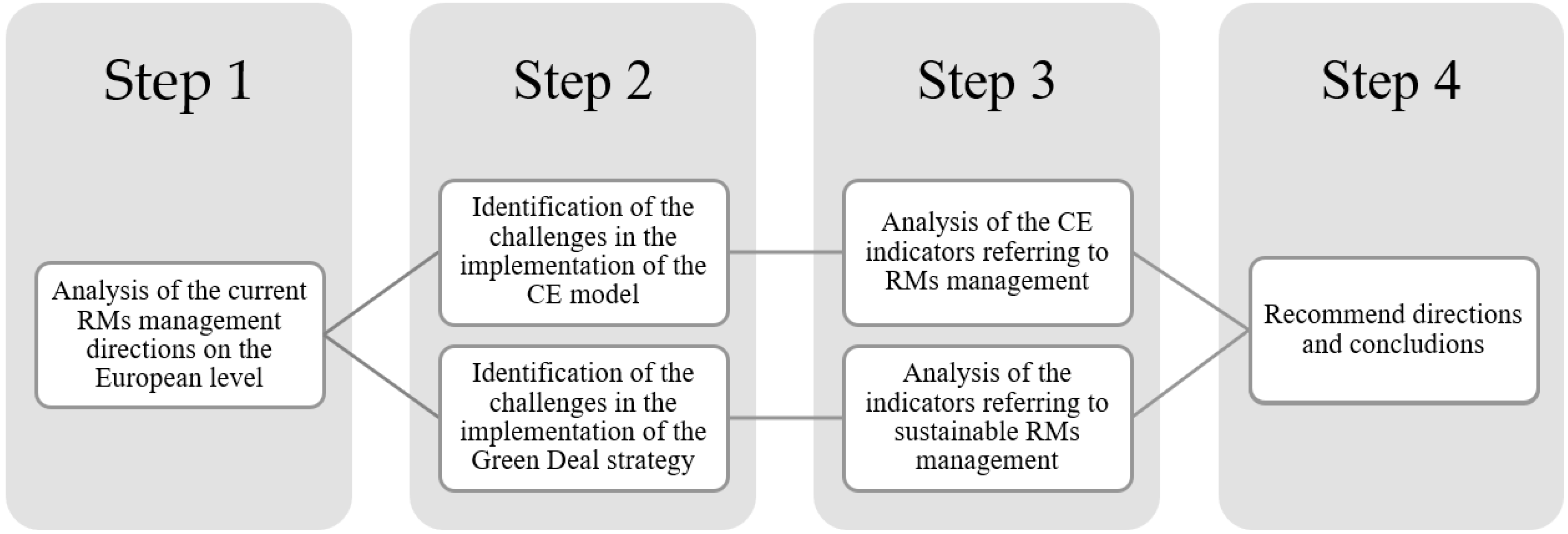
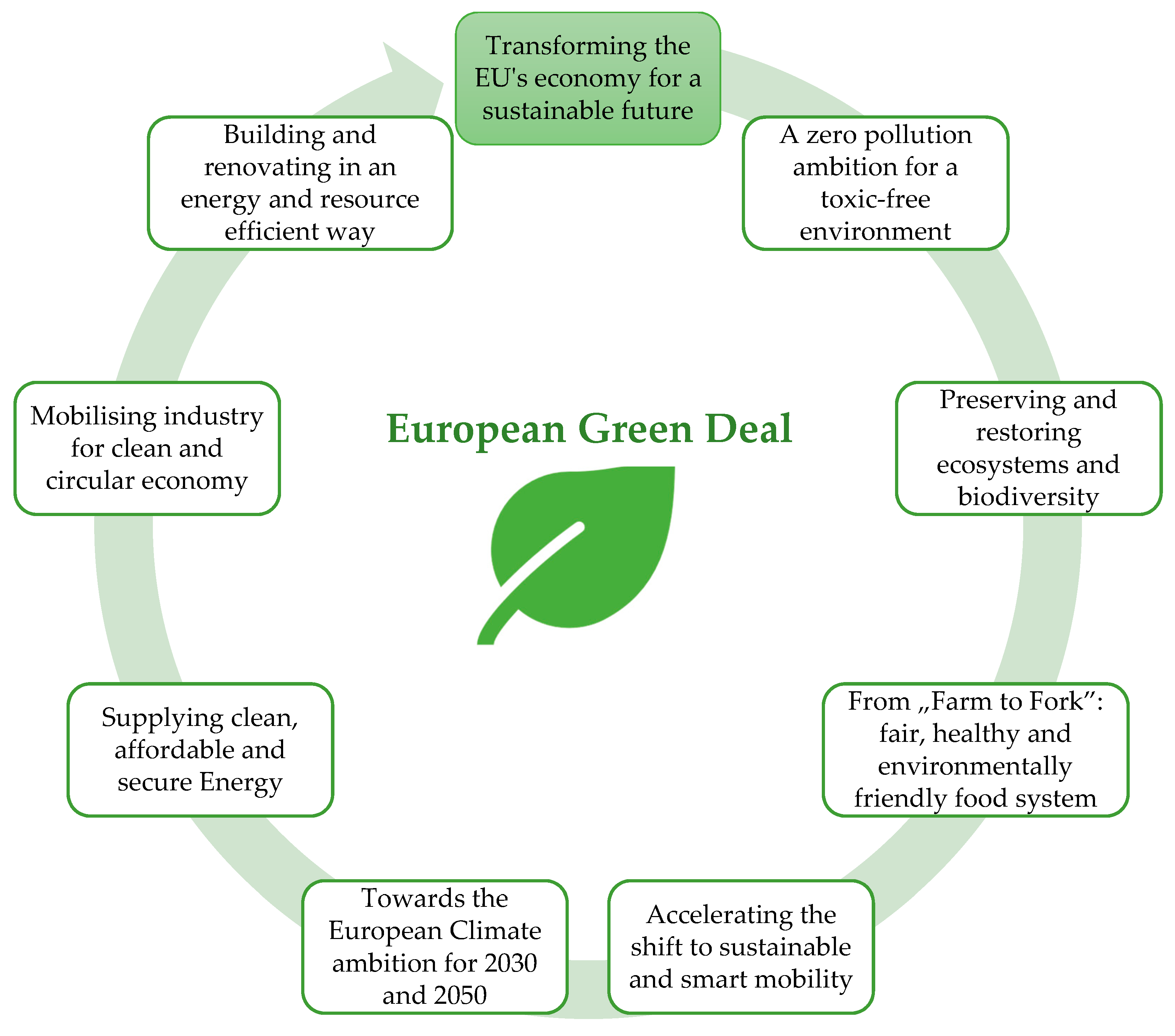
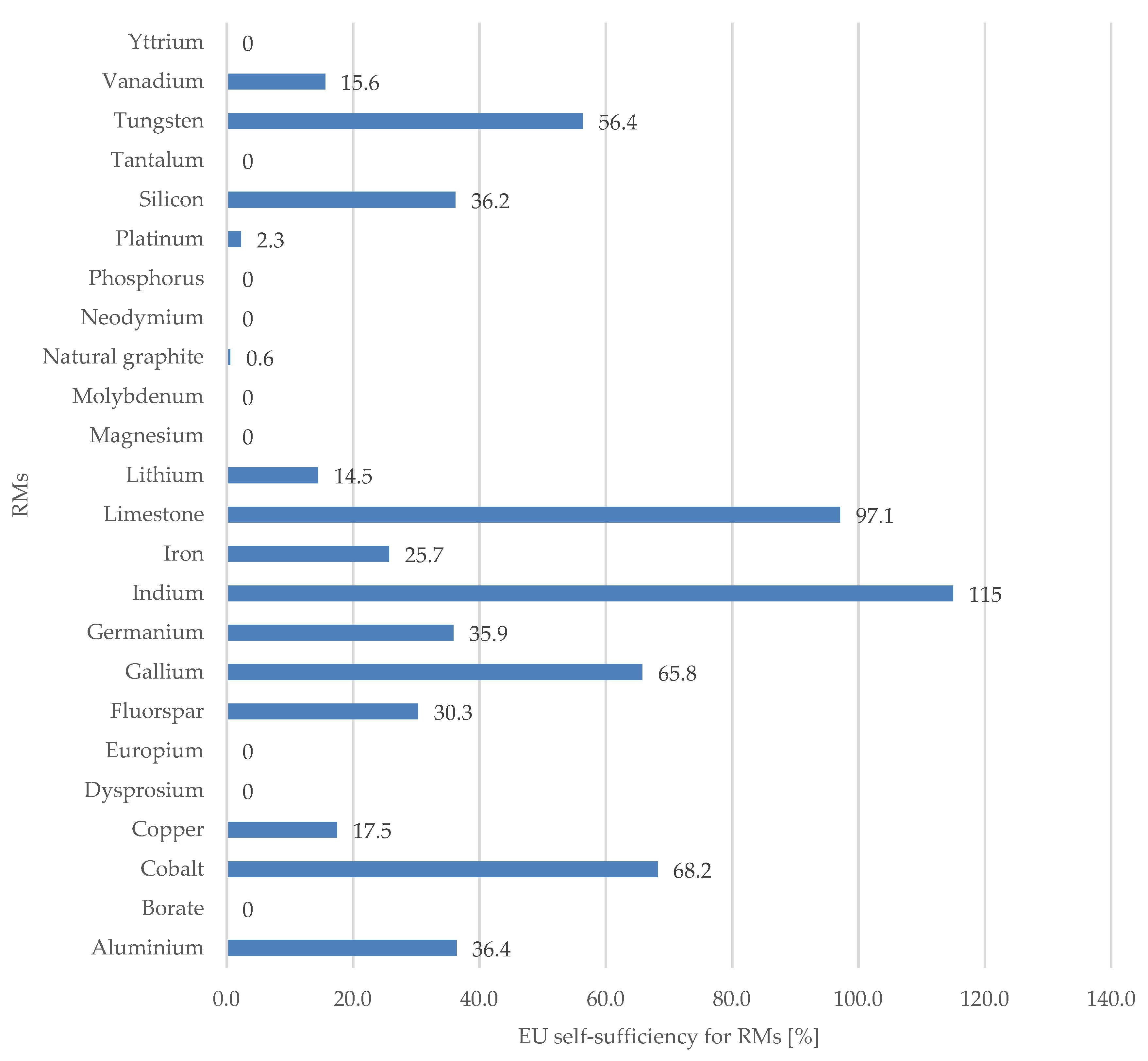
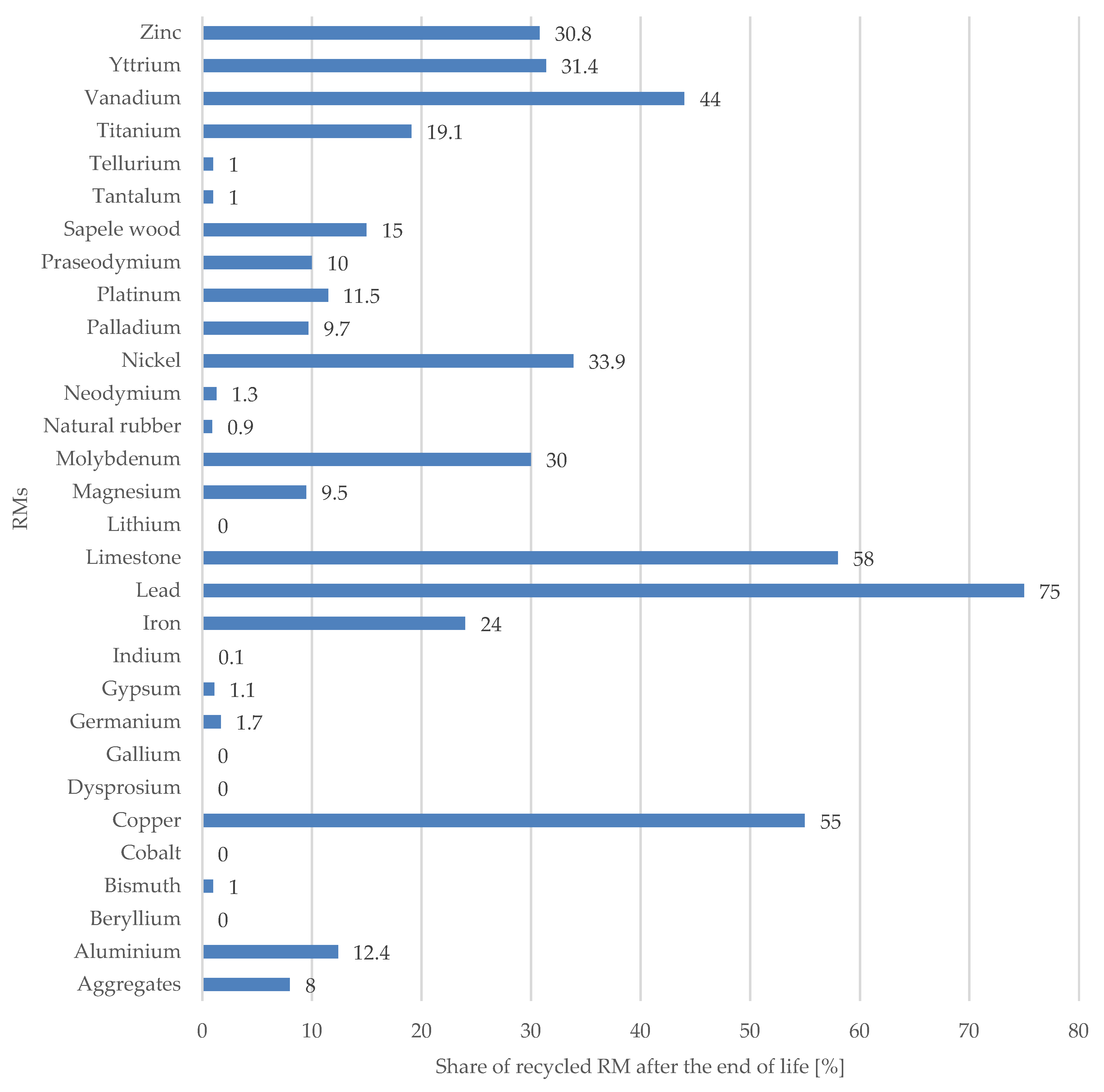

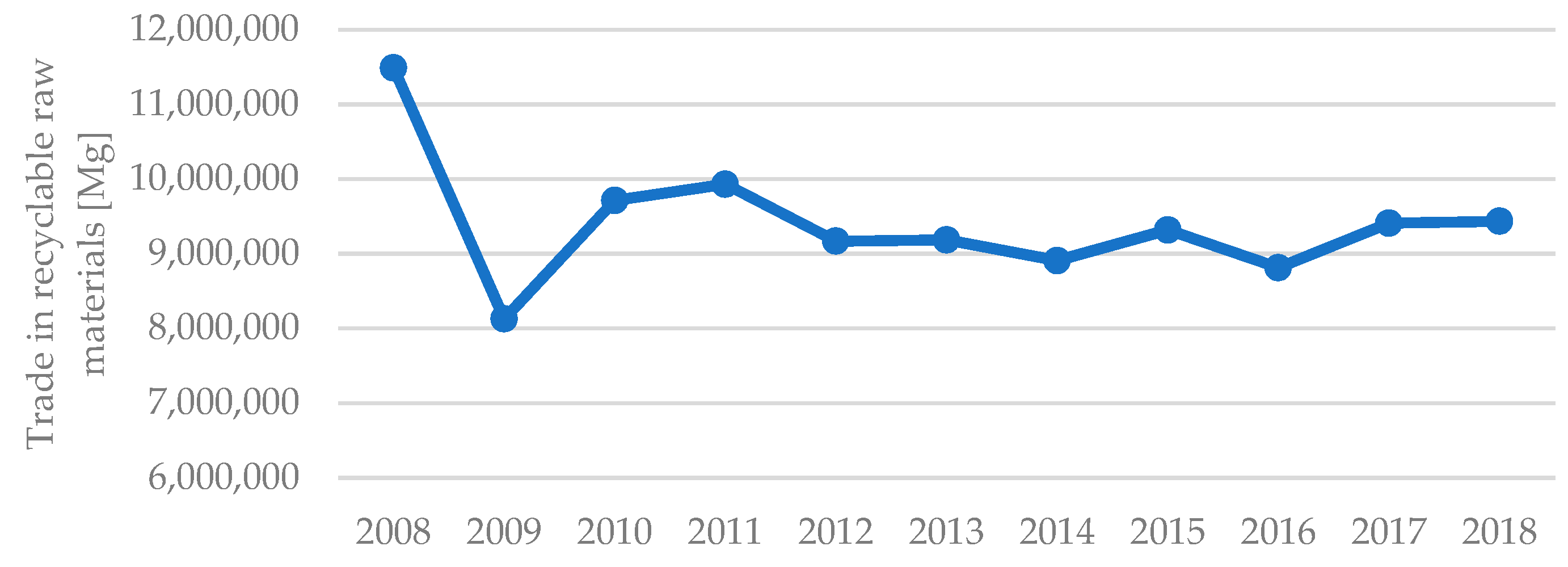
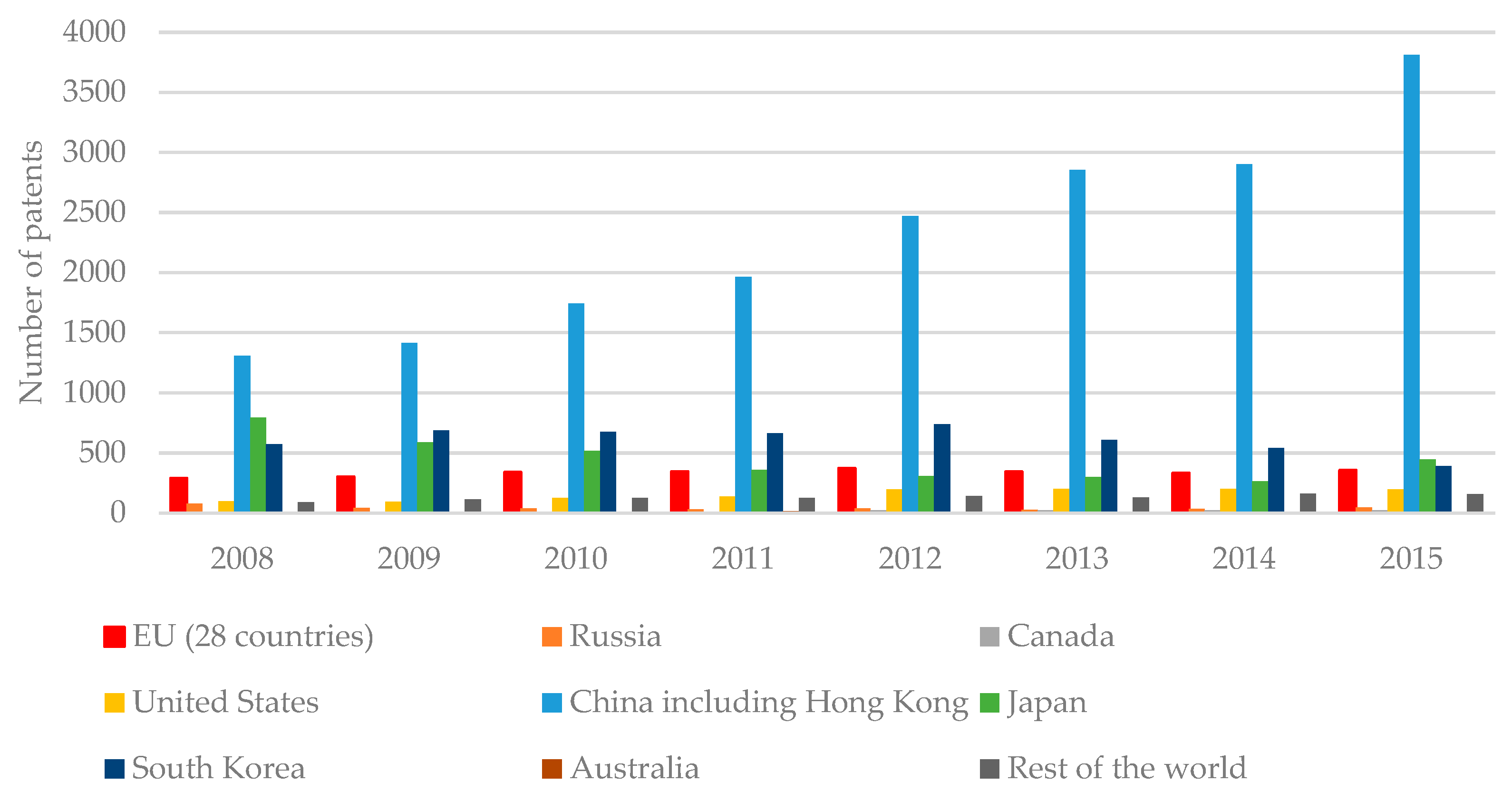
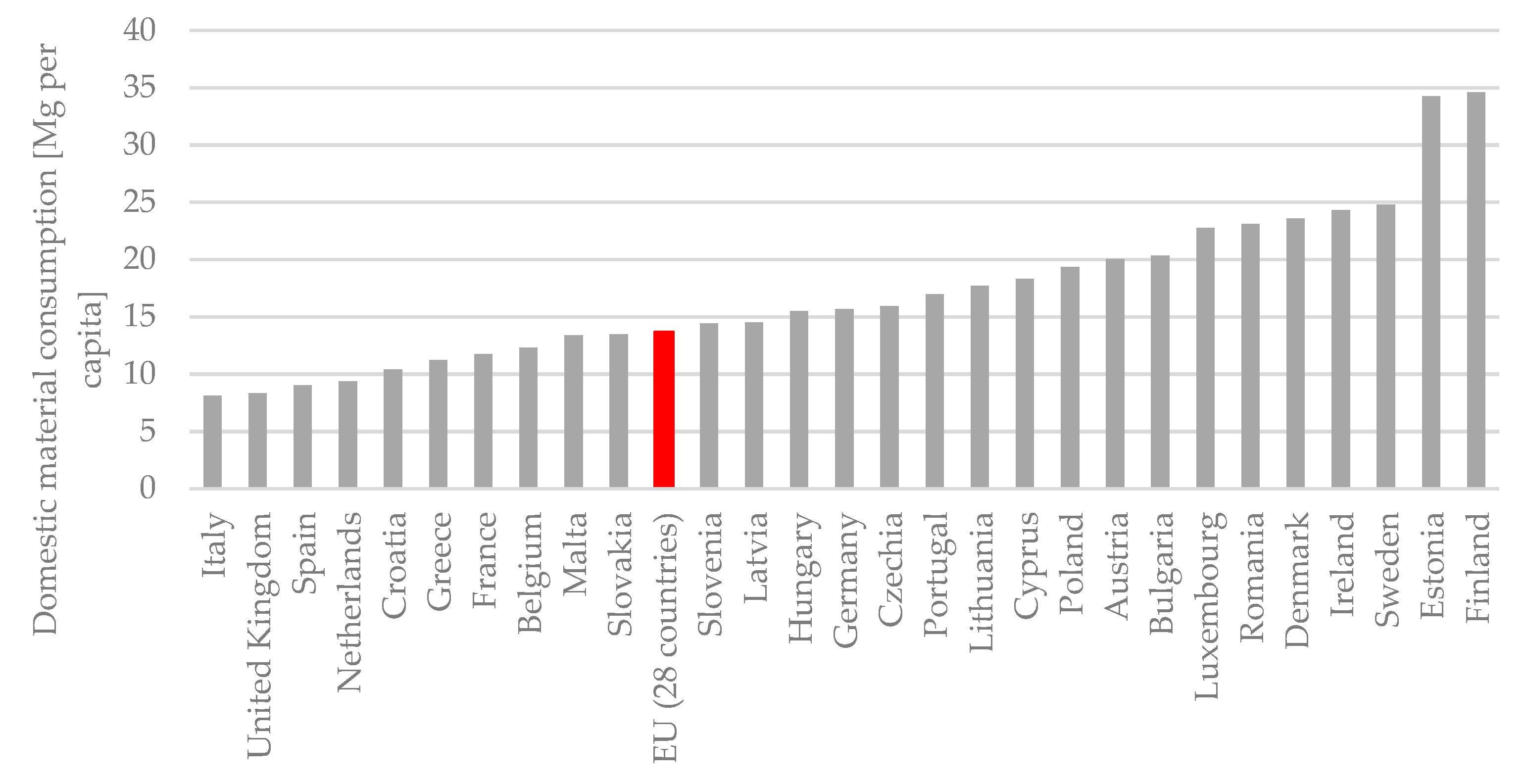
| CE Indicator | Definition | Relevance | |
|---|---|---|---|
| Production and Consumption | |||
| EU self-sufficiency in raw materials | This measures how much the EU is independent from the rest of the world for several RMs | RMs are essential for the functioning of the EU’s economy. A wide variety of industrial sectors depend on the secure supply of RMs, typically in a diversified mix of domestic extraction, recycling and imports. | |
| Secondary Raw Materials | |||
| Share of secondary raw materials in the demand for raw materials (end-of-life recycling input rates) | This measures, for a given RM, how much of its input into the production system comes from recycling of “old scrap”, i.e., scrap from end-of-life products | In a world of increasing demand for RMs, the use of secondary RMs can help to improve the EU’s security of supply, reduce the extraction pressure on natural resources, and therefore reduce related pressures on the environment, and contribute to developing a solid circular economy at sub-national, national and European scales | |
| Circular material use (CMU) rate | This measures the share of material recovered and fed back into the economy—thus saving the extraction of primary raw materials—in overall material use. The CMU rate is defined as the ratio of the circular use of materials to the overall material use | CE aims at increasing the amount of material recovered and fed back into the economy, therefore reducing the generation of waste and limiting the extraction of primary RMs. The circular material use rate measures the contribution of recycled materials to the overall materials demand | |
| Trade in secondary raw materials | Imports from non-EU countries | This measures the quantities of selected waste categories and by-products imported by EU Member States from third-world countries | Indicator is clearly relevant for obtaining a complete picture of trends in the markets for secondary raw materials, at both national and EU-28 levels. It is an indicator that is used by the European Commission, for example in the Raw Materials Scoreboard |
| exports to non-EU countries | This measures the quantities of selected waste categories and by-products exported by EU Member States to third-world countries | ||
| Intra EU trade | This measures the quantities of selected waste categories and by-products imported by EU Member States from another Member State | ||
| Competitiveness and Innovation | |||
| Patents related to recycling and secondary raw materials | This measures the number of patents related to recycling and secondary raw materials. The attribution to recycling and secondary raw materials was done using the relevant codes in the Cooperative Patent Classification (CPC) | Innovation will necessarily play a key role in the transition towards a circular economy, in the development of new technologies, processes, services and business models. Patent statistics are one of the indicator families widely used to assess technological progress in a specific industrial sector. | |
| Sustainable Resource Management | |||
| Domestic material consumption (DMC) | This measures the total amount, in Mg, of material directly used in an economy, either by businesses, government and other institutions for economic production or by households. DMC is measured in Mg of extracted natural resources per year. DMC equals the extractions of materials used by producer units in the economy plus imports—called direct material input (DMI)—minus exports. The value of DMC also indicates the waste potential of a given region | This quantifies the demand for material extractions (biomass, metal ores, non-metallic minerals and fossil energy materials/carriers) triggered by consumption and investment by households, governments and businesses in the EU | |
| Raw material consumption (RMC) | This measures the material footprint of the EU as a whole | RMC represents the total amount of extracted raw materials needed to produce the goods and services consumed by residents of the EU | |
| Resource productivity (GDP/DMC) | This measures of the total amount of materials directly used by an economy, or domestic material consumption (DMC) in relation to gross domestic product (GDP) | This provides insights on decoupling between the use of natural resources and economic growth and used as an EU sustainable development indicator for policy evaluation | |
| EC Targets | Sustainable Development Aspects | ||
|---|---|---|---|
| Economic | Environmental | Social | |
| CE Model | Increasing resource efficiency | Reducing global pressure on resources and rising insecurity of supply | Building a recycling society |
| Green Deal Strategy | Building more competitive Europe in co-creation with economic actors, consumers, citizens and civil society organizations | Building a cleaner and climate-neutral Europe in co-creation with economic actors, consumers, citizens and civil society organizations | Building a fair and prosperous society |
| Recommended Actions for the Sustainable and Circular RMs Management | |||
| Setting up a policy framework in different areas of the RMs management | |||
| Delivering improvements or innovative business models on the market | Eco-design—ease of dismantling products to reduce raw materials use in new products | Promoting collaborative economy such as sharing cars, bikes, clothes and working spaces. | |
| Eco-design—ease of dismantling products to reduce dismantling costs | Provide incentives and use economic instruments, such as taxation, to ensure that product prices better reflect environmental cost | Developing the necessary services for consumers in this regard (maintenance/repair services | |
| Boosting markets for secondary raw materials (recyclates) | Delivering environmental impact measurement in product and process design and in providing consumers with better information on environmentally sustainable choices | Delivering trustworthy and relevant information about products to consumers at the point of sale, including on their lifespan and the availability of repair services, spare parts and repair manuals | |
| Providing balance between products prices and the real costs of resource use to society | Delivering safe usage of waste as a source of secondary RMs | Strengthening consumer protection against green washing and premature obsolescence, setting minimum requirements for sustainability labels/logos and for information tools | |
| Boosting innovation by financial support under EU Research and Innovation Programmes as Horizon 2020 and Horizon Europe and other international and national financial instruments | Promoting the uptake of green technologies through a system of solid verification by registering the EU Environmental Technology Verification scheme as an EU certification mark | Creating of a network of platforms aimed at collaboration on the regional, national and international level in the area of RMs management | |
| Promoting greater use of economic instruments—general requirements for extended producer responsibility schemes | Stimulate innovation in recycling and reuse, limit landfilling, reduce loss of resources and create incentives for behavioural change | Developing the necessary services for consumers in this regard (maintenance/repair services | |
| Supporting recycling technologies’ development by innovative financial instruments, reflecting resource issues in accounting rules for companies, clarifying the sustainability responsibilities of financial institutions (fiduciary duties) | Foster circular industrial collaboration among SMEs | Incentivising and supporting waste reduction and high-quality separation by consumers | |
| Developing methodologies for ‘resource stress tests’ for companies, and exploring the potential of the bonds market to channel additional finance for resource efficiency projects | Supporting development of solutions for high-quality sorting and removing contaminants from waste | Encouraging wider and better consumer choice through renting, lending or sharing services as an alternative to owning products, while safeguarding consumer interests (in terms of costs, protection, information, contract terms, insurance aspects, etc.) | |
| Creating longer-term predictability for investment and change so that materials, such as plastics, glass, metals, paper, wood, rubber and other recyclables, re-enter the economy as secondary raw materials at competitive prices | Improving modelling tools to capture the benefits of the CE on greenhouse gas emission reduction at EU and national levels | Incentivising separation, collection systems that minimise the costs of recycling and reuse | |
| Evaluation of the feasibility of establishing a market observatory for key secondary materials | Promoting direct investment in waste management options at the top of the waste hierarchy (prevention, re-use, recycling) | Facilitating the clustering of activities to prevent by-products from becoming wastes (industrial symbiosis) | |
| Providing financial support for companies operating in RMs mining, substitution and recovery sector | Performing life cycle assessments in order to choose the most appropriate (environmentally friendly) solutions | Initiating a multi-disciplinary dialogue involving individuals next to the policymakers, companies, high-education institutions, researchers about the benefits of the sustainable and circular RM practices | |
| Providing green taxes for businesses—tax relief for becoming more RM-efficient | Performing risk analysis to provide products that are safe for human health | Education of different groups of stakeholders (kids, students, individuals, policymakers) on the importance of the sustainable and circular RMs’ management | |
© 2020 by the authors. Licensee MDPI, Basel, Switzerland. This article is an open access article distributed under the terms and conditions of the Creative Commons Attribution (CC BY) license (http://creativecommons.org/licenses/by/4.0/).
Share and Cite
Smol, M.; Marcinek, P.; Duda, J.; Szołdrowska, D. Importance of Sustainable Mineral Resource Management in Implementing the Circular Economy (CE) Model and the European Green Deal Strategy. Resources 2020, 9, 55. https://doi.org/10.3390/resources9050055
Smol M, Marcinek P, Duda J, Szołdrowska D. Importance of Sustainable Mineral Resource Management in Implementing the Circular Economy (CE) Model and the European Green Deal Strategy. Resources. 2020; 9(5):55. https://doi.org/10.3390/resources9050055
Chicago/Turabian StyleSmol, Marzena, Paulina Marcinek, Joanna Duda, and Dominika Szołdrowska. 2020. "Importance of Sustainable Mineral Resource Management in Implementing the Circular Economy (CE) Model and the European Green Deal Strategy" Resources 9, no. 5: 55. https://doi.org/10.3390/resources9050055
APA StyleSmol, M., Marcinek, P., Duda, J., & Szołdrowska, D. (2020). Importance of Sustainable Mineral Resource Management in Implementing the Circular Economy (CE) Model and the European Green Deal Strategy. Resources, 9(5), 55. https://doi.org/10.3390/resources9050055






